Team-BHP
(
https://www.team-bhp.com/forum/)
I think I am now confused between these two options:
Option A> i20 N Line N8 DCT
Option B> i20 N Line N8 iMT
While Option B frees up the left leg, Option A frees up both left leg and left hand :)
During my short test drive with iMT, I did not like having to shift gears too often (even if left leg being free was great, the left hand was generally engaged). But at the same time, the iMT transmission technology is more proven, time-tested, reliable and easier to repair & maintain compared to a DCT.
The other thought is this - goodness forbid, if something goes wrong - it looks to be very difficult to get the DCT repaired by my trusted local mechanic. With iMT having an MT as the base, that wouldn't be an issue.
Quote:
Originally Posted by souvikjana83
(Post 5316515)
What I understood by looking at DCT issues videos and reading about them is that dry DCT which is being used in Hyundai and Kia cars are not ideal in traffic and in summer season. The main reason is overheating and higher wear and tear. A CVT or Automatic transmission is better suited to Indian conditions. A wet DCT which now comes in Altroz may be a better alternative since the coolant will keep the temperature down.
You should check out the best practices to use DCT before going ahead with it.
|
Thanks @souvikjana83. I was keenly observing Tata Altroz DCA, but guess what? In Pune they are unable to even arrange for a TD vehicle since 15th March 2022! I even said to them, get me any Altroz for test drive to begin with: Turbo Petrol/DCA/Diesel - any variant will do - so that I at least get a feel of Altroz (have read a lot of positive reviews about Altroz) and they kept promising they will arrange for a vehicle and confirm the TD timeslot, and that would be the end of the story! They never got back, and whenever I followed up again, they said that the car was either broken and under servicing, or was away to a different showroom of the dealership, expected to get back in a few days!
After around 10 unsuccessful attempts, I gave up. All I have is the full conversation log with them!
Tata Motors simply does not seem to care about their prospective customers! If they do not care for their prospects, I wonder if and how much they would care about their actual customers! Can't buy a car from such folks and keep hoping all would be good when we require after-sales service & support!
S Tronic transmission
Reinvigorating this engaging thread with some information on yet another member of the DSG family: the
S Tronic.
And the reason why I wish to do so is because, my association with the DSG family continues for the foreseeable future, courtesy the super Audi A4 (
sneak peek to the initial review).
As some of you might be aware, my Vento kept excellent company for close to 6.5 years/87,000+ km and the DSG experience was nothing short of top class! Well, I could actually write a few words in this thread as a testament to that fantastic experience.
The S Tronic, a term designed by Audi for differentiation within the VAG, is essentially part of the DSG family. Which means, it is the same dual-clutch configuration found in other DSG variants.
Speaking of DSG variants, here is the line-up with some details:
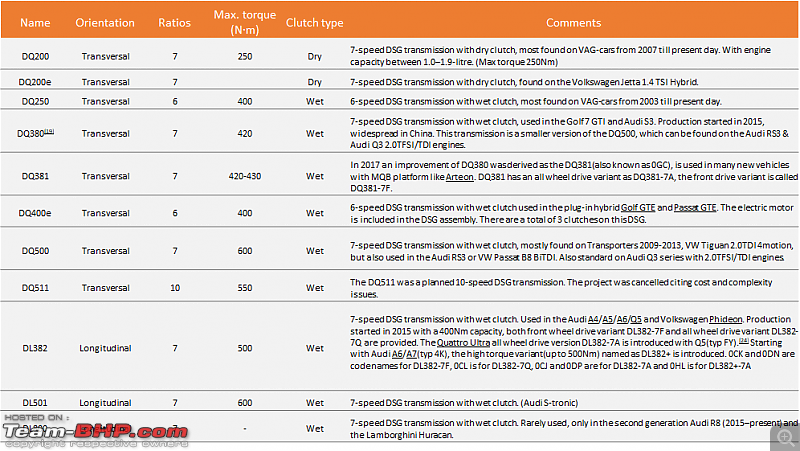
In this post, let me try to pen down whatever I have understood so far. By no means, do I claim my understanding to be exhaustive. So, please treat this post as an endeavor of my humble effort to share what I have learnt so far.
The S Tronic, in my Audi A4, is given the name
DL 382 - 7F. Codename: 0CK. (it's the number '0', not the alphabet 'O')
D = DSG
L = Longitudinal engine
382 = evolution of the nomenclature related to estimated max torque
7 = seven speeds or gears
F = front wheel drive
There's also the DL382-7Q ('Q' for quattro). And the DL382-7A ('A' for All wheel drive).
While the smaller DQ200's (in my Vento) torque handling capacity was 250 Nm, the larger DL382 can handle technically upto 500-550 Nm. One of the fundamental difference is the usage of larger and separate oil 'chambers' or circuits in the S Tronic, giving it flexibility to dissipate a lot of heat under high loads during starting and instant acceleration etc.
By the way, the S Tronic is not the same as a Multitronic or Tiptronic. While the S Tronic is a dual clutch setup, the Multitronic is a continuously variable transmission (CVT) (
details) and the Tiptronic is a more traditional automatic gearbox featuring a torque converter (
details).
Going back to how it operates, the S Tronic has exactly the same principle like other DSGs.
The S Tronic comprises two subunits and integrates two multi-plate clutches that control the various gears. The large K1 clutch located on the outside directs the torque via a solid shaft to the gear wheels for the odd-numbered gears 1, 3, 5 and 7. A hollow shaft rotates around the solid shaft. It is connected to the smaller K2 clutch, which is integrated into the inside of its larger sibling, and which controls the gear wheels for the even-numbered gears 2, 4 and 6, as well as the reverse gear.
Both transmission structures are continuously active, but only one is connected to the engine at any one time. For example, when the driver accelerates in third gear, the fourth gear is already engaged in the second transmission structure. The shifting process takes place as the clutch changes – K1 opens and K2 closes.
For longitudinally installed engines, Audi has developed a special version of the seven-speed S Tronic in which the gear wheels for all gears are situated one behind the other on an output shaft. The three versions for transversely installed engines are configured in a single layout with two output shafts, allowing a compact design. The S Tronic for transverse engines is available with six or seven gears.
The seven-gear S Tronic itself has three sub-versions. Which sub-version is used with which engine depends on the amount of torque to be transmitted. Per Audi, the S Tronic for longitudinal engines can handle engine speeds of up to 9,000 rpm.
Below are some diagrams extracted from public domain sources.
Firstly, the overall schematic of the S Tronic assembly:-
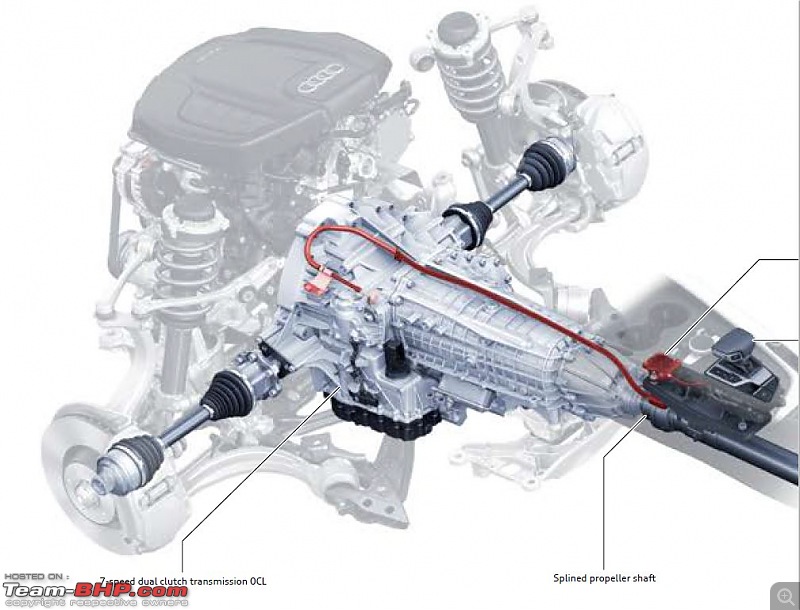
When seen from the car underbody, this is how it looks:-
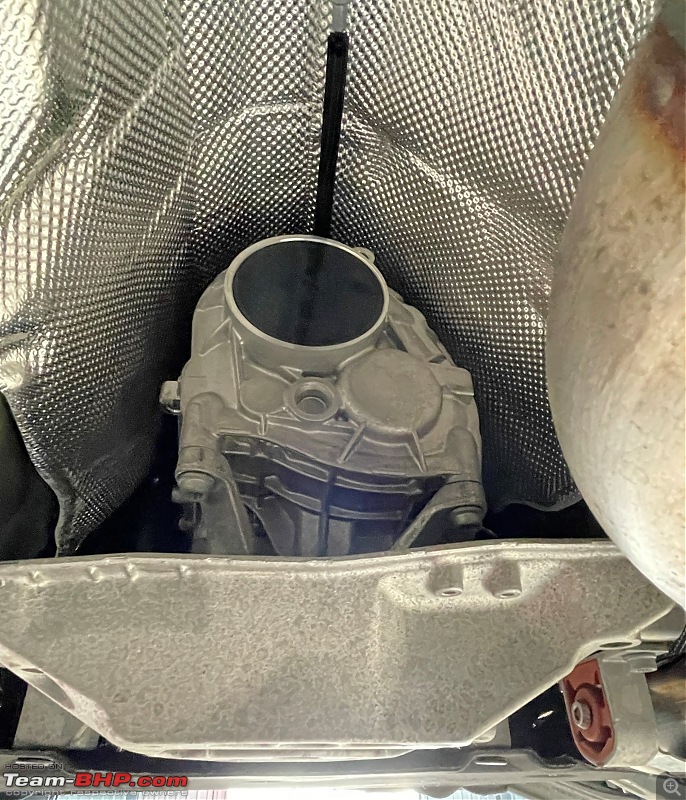
Given its strategic importance, the box is protected underneath.
A slightly closer look at the 7F (0CK) front wheel drive variant, explaining some of the parts:-
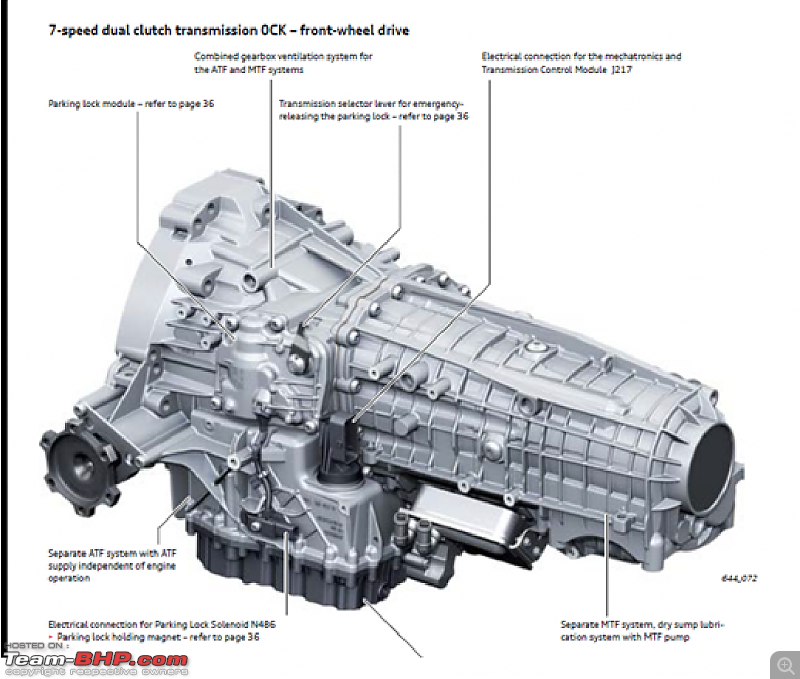
As per certain sources, the DL382 is the redesigned avatar of the DL501 gearbox.
The linear architecture of the 7-speed gearbox:-
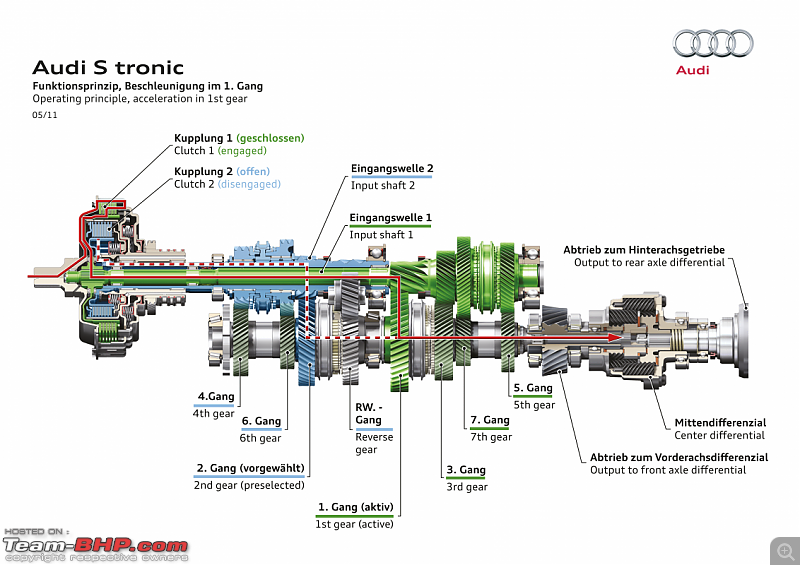
The selector lever assembly:-
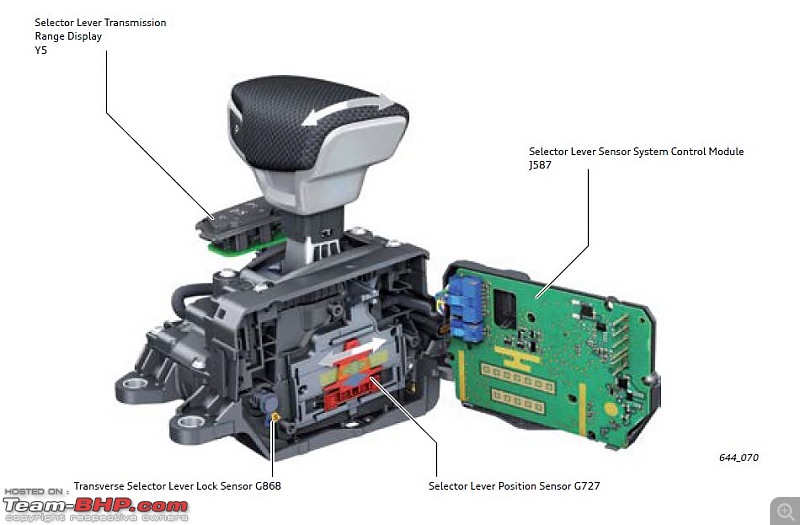
And the component-by-component view:-
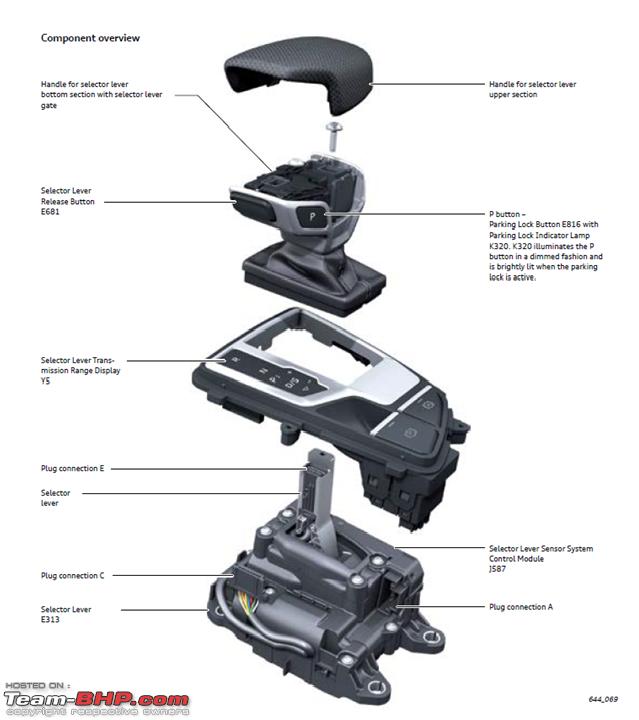
To make things slightly interesting, here is the function diagram of the selector mechanism:-
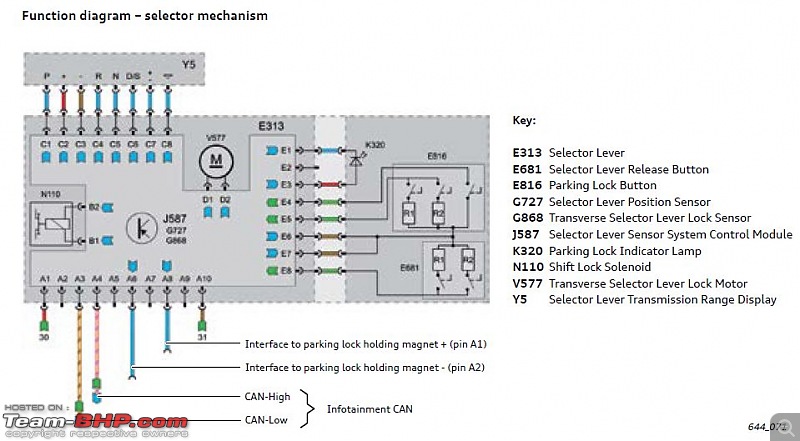
Here is a diagram showing some of the special features of the newly developed S Tronic:-
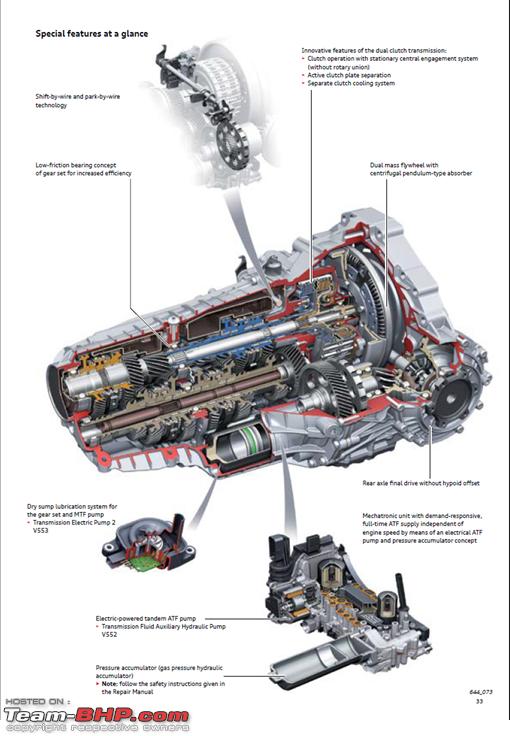
One of the key features, talked about highly in various forums is the shift-by-wire/park-by-wire technology.
The A4 (B8 gen onwards) uses the latest 'Audi selector' mechanism with full shift-by-wire capability (SBW). This means that parking lock operation is also fully automatic. The term used for this is "park-by-wire" (PBW). There is no selector cable connecting the selector mechanism to the transmission.
The parking lock is not solely controlled by the mechatronics unit. the selector mechanism is also actively involved.
Coming to speed, Audi says that the 0CK gearbox's top speed is in the 6th gear. In the 7th gear, the engine speed is reduced for better fuel efficiency.
Now, in addition to the above diagrams, I came across some beautiful videos as well. Specially, there's a site which has this technical illustrations all nicely done up, please do check out this website -
Digital Media Technik
They have a variety of technical animations covering multiple topics. They claim that all the illustrations have been reproduced with permission from the OEM.
Here's a YouTube video with a slightly different take:-
https://www.youtube.com/watch?v=1CRzHvTW0dI
However, any DSG story is not complete without its fair share of warnings or ominous messages. For this one too, Audi has shared a list of what can go possibly wrong along with some specific messages.
These are categorized into 3 types:-
Transmission errors with 'red' colored icon on the MID:-

The 'red' are the serious ones indicating a malfunction or the transmission temperature getting too hot. Advised to stop the car immediately.
Transmission errors with 'yellow' colored icon on the MID:-

The 'yellow' errors are due to a malfunction but you can continue to drive by adapting the driving style: this error could be due to limited functionality of the gearbox (for e.g. only even or odd gears) or problems with the selector lever (then recommended to use only paddle shifters)
Transmission errors with 'white' colored icon on the MID:-

This 'white' error is the least disruptive of the set, and is possibly due to a malfunction in the tiptronic mode.
Summary
Taking into account the above information, it becomes clear that S Tronic characteristics significantly contribute to superior driving convenience, enhanced car dynamics, and fuel saving.
A new car equipped with this transmission can impress the owner with smooth gear shifting and great acceleration characteristics in comparison with cars equipped with classic automatic transmissions and CVTs. It has certainly impressed me, a lot!
However, operation principles of this transmission are based on complex algorithms and its design includes the mechatronics as well as numerous servomechanisms. As a result, this transmission is expensive and complex, and possibly with its own share of problems. Maybe not as frequent as the younger siblings of the DSG family.
All information in this post taken from public sources & owner manuals. Will attempt to update this as I learn more.
Quote:
Originally Posted by JoshMachine
(Post 5326883)
S Tronic transmission
The S Tronic, a term designed by Audi for differentiation within the VAG, is essentially part of the DSG family.
However, operation principles of this transmission are based on complex algorithms and its design includes the mechatronics as well as numerous servomechanisms. As a result, this transmission is expensive and complex, and possibly with its own share of problems. Maybe not as frequent as the younger siblings of the DSG family.
|
Thanks for this :thumbs up.
Any thoughts on whether the Audi S-Tronic versions are technically superior and/or more reliable than the Skoda / VW versions? I have cheesed off multiple Audi sales advisors by bringing up the infamous DQ200 in front of them, hence asking. :D
Quote:
Originally Posted by itwasntme
(Post 5327356)
Thanks for this :thumbs up.
|
You are welcome :)
Quote:
Any thoughts on whether the Audi S-Tronic versions are technically superior and/or more reliable than the Skoda / VW versions? I have cheesed off multiple Audi sales advisors by bringing up the infamous DQ200 in front of them, hence asking.
|
In principle, yes in my view, the Audi S Tronic (DL382 series) is technically superior to the smaller DQ200. The S Tronic uses 2 larger oil chambers - one for the transmission fluid and the other for hypoid gearbox oil. This separation & usage of significantly large oil quantity greatly reduces contamination of debris + other wear & tear particles slipping into various sub-components and causing chaos. Ofcourse, there are other salient features like how the gear selector operates, how the mass flywheel is tuned and so on.
Having a large oil cooling circuit or chamber naturally increases the dissipation and tolerance to heat, a crucial factor in determining the general reliability of the gearbox components.
Among other things, the main grouse with the DQ200 was/is the "dry" dual clutch plates getting burnt out due to overheating. As most of us know by now, this was a direct consequence of the compact design that VW wanted for its lighter cars. VW mitigated that solution by switching to mineral oil but looks like that may not be a 100% reliable solution.
I vaguely recall you also having trouble with your Octavia's DSG/DQ200 box before you got the Bimmer.
Quote:
Originally Posted by JoshMachine
(Post 5327416)
Among other things, the main grouse with the DQ200 was/is the "dry" dual clutch plates getting burnt out due to overheating. As most of us know by now, this was a direct consequence of the compact design that VW wanted for its lighter cars. VW mitigated that solution by switching to mineral oil but looks like that may not be a 100% reliable solution.
|
This is interesting. While Audi's S-Tronic is for different segments altogether, what would your thoughts be about the DQ-381 7F used in the facelifted Superb and the new Octavia? It is a wet-clutch unit with a higher torque rating (no longer running at the maximum possible torque with the 2.0 TSI generating 320 Nm), and an improved version of the older DQ-380 unit.
@JoshMachine, thanks again but I meant comparo between identical VAG & Audi units like the dry clutch ones in the Octavia & A3.
:D yes, my DQ200 was replaced under warranty.
Quote:
Originally Posted by GForceEnjoyer
(Post 5327422)
what would your thoughts be about the DQ-381 7F used in the facelifted Superb and the new Octavia?
|
Yes, the DQ381 is the improved version of the DQ380 (which itself was a smaller variant of the DQ500), with supposedly higher torque rating.
The 380's max torque was claimed to be 420 Nm but for practicality/marketing, it was capped to 380 Nm, hence the moniker.
While the DQ380 was mostly produced in & for the Chinese market, the aim of continuously reducing fuel consumption and CO2 emissions made it necessary for Volkswagen AG to develop a more efficient version of this transmission for the European market. This resulted in 2017 to the introduction of the DQ381 (0GC) gearbox. It has been designed for front and all-wheel drive cars, having transverse engine assembly. Hence the Skoda Superb too, gets this gearbox.
In conclusion, the DQ381, courtesy the refinements + higher torque, is claimed to be more reliable.
Quote:
Originally Posted by itwasntme
(Post 5327484)
@JoshMachine, thanks again but I meant comparo between identical VAG & Audi units like the dry clutch ones in the Octavia & A3.
|
Sorry, don't have much info in terms of the technical differences for the DQ200 in the Audi A3 vs the VAG cars. Having said this, I would think Audi may be using the exact same gearbox for that segment (read: may not be interested to play around with smaller margin luxe cars).
However, for >A3 segment onwards, is where I think Audi is really making the S Tronic sweat and do some good.
Quote:
Originally Posted by JoshMachine
(Post 5327694)
The 380's max torque was claimed to be 420 Nm but for practicality/marketing, it was capped to 380 Nm, hence the moniker.
|
Wow, I did not know that. So this unit technically capable of handling 420 Nm.
Quote:
While the DQ380 was mostly produced in & for the Chinese market, the aim of continuously reducing fuel consumption and CO2 emissions made it necessary for Volkswagen AG to develop a more efficient version of this transmission for the European market. This resulted in 2017 to the introduction of the DQ381 (0GC) gearbox.
In conclusion, the DQ381, courtesy the refinements + higher torque, is claimed to be more reliable.
|
Thanks a lot for your insight. Fingers crossed that the unit in our Superb doesn't throw up issues, and if it decides to do so, only within the warranty period. rl:
Quote:
Originally Posted by JoshMachine
(Post 4547770)
3rd Commandment-
Traffic Signal: Thou shall try to gradually come to a complete halt at a traffic signal. If the stoppage time is reasonably more (e.g. more than 20 seconds) then thou shall shift the gear lever into "neutral" and pull the handbrake or depress the main brake pedal (preferred). Thou shall not 'ride' the brake pedal
|
I was just doing some random browsing and landed on this page that contradicts the third commandment.
https://gomechanic.in/blog/things-yo...mission/?amp=1
It not only advises NOT to engage the vehicle in neutral in traffic lights, but goes on to say that riding the brakes wouldn’t harm the system 😀 .
Quote:
Originally Posted by careind
(Post 5335294)
I was just doing some random browsing and landed on this page that contradicts the third commandment.
It not only advises NOT to engage the vehicle in neutral in traffic lights, but goes on to say that riding the brakes wouldn’t harm the system 😀 .
|
The general context here, is to not let the dual clutch plates be engaged/pre-selected and get overheated unnecessarily at a traffic light having long stoppage time, by keeping the transmission still in "D" mode and using the brakes to keep the car stationary.
This thread should be published in Automobile Engineering textbooks!
Brilliantly well-researched and supremely informative.
Just wondering: The S-Tronic is named according to the way the engine is mounted. Hence the L in DL382-7F. So why are the DQ's not named DT instead? (T referring to the transverse mounted engines)
Also missing is the number of gears and drivetrain type. So we have, for example the DQ200 instead of the DT200-7F
Quote:
Originally Posted by TheGearBox
(Post 5342976)
This thread shall be published in Automobile Engineering textbooks!
|
Amen, :D
Quote:
Just wondering: The S-Tronic is named according to the way the engine is mounted. Hence the L in DL382-7F. So why are the DQ's not named DT instead? (T referring to the transverse mounted engines)
|
I presume the letter "
Q" in D
Q gearbox has its origin in the German word "M
QB"(
Modularer Querbaukasten), meaning
Modular Transversal Toolkit in simple English :)
Quote:
Also missing is the number of gears and drivetrain type. So we have, for example the DQ200 instead of the DT200-7F
|
Correct, gear & drivetrain info is missing in the smaller variants like the DQ200.
Again, my hypothesis here - there is only a single variant of the DQ200 being used by many sub-brands in the family, hence no need for VW to create unnecessary confusion.
On the other hand, the heavyweight DSG siblings (torque >250 Nm) are being used all over the place, hence the need (read: marketing differentiation) to resort to esoteric jargons.
Thank you for such an informative and well-researched and complied article. It still stands tall as a ready reckoner for people like me, even years after it was started by you. That tells you how good the information here is!
This is the reason why Team-BHP stands out for me - this level of enthusiasm and deep-diving into an issue that most car buyers would not even consider - until they are smitten by the hand of god and cry for not having read and understood the 10 Commandments!
As you are quite exprerienced in this matter - and as I am someone who is a newbie who has recently gotten enamoured of the VGA group of cars, could I ask you: does it make more sense to go for the DSG (with notorious Mumbai traffic) or the MT? The advantage being one can upgrade to a 1.5 TSI with MT at almost the same price for a 1.0 AT, which I didn't really found particularly exciting to drive.
To be honest, am a sedate driver but do a lot of cross-state highway runs, mainly Rajasthan, Goa and the south and am not very fond of the few ATs I have driven, albeit for short periods of time.
Thank you
Quote:
Originally Posted by JoshMachine
(Post 4547770)
Summarizing few observations and practices in the form of 10 Commandments
|
Thank you for a terrifically informative thread, @JoshMachine. Hope my questions makes sense, my apologies if these are too basic.
First question: I understand that using the paddles alone, without shifting the gear lever to manual, is only a temporary measure. The DSG takes over if there are no other inputs after sometime (several seconds?). Does the same happen if the gear lever is shifted to manual? Does the DSG take over after a time gap of 10-20 seconds or does it continue to stay in manual until the driver shifts the gear lever back to automatic?
Following from the above, my second question: if we switch to manual by sliding the gear lever physically to manual and continue using it in manual, either via the gear lever or via the paddles, will the twin clutch still anticipate and keep the next gear ready? In other words, under this condition, does the system then "rest", as the driver has indicated he/she is selecting the appropriate gear? Or does putting it on manual by sliding the gear shift not have any effect as far as the system is concerned? Say, if in manual in 3rd gear, and slightly accelerating, will the DSG keep the 4th gear ready or will it wait until the driver chooses whether to shift up to 4th or down to 2nd? Thanks, very much!
| All times are GMT +5.5. The time now is 10:06. | |













